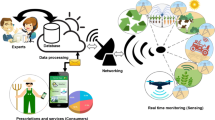Abstract
Machine-to-machine (M2M) communications have emerged as a new technology for next-generation communications. As the number of M2M devices and the amount of transmitted data increase, applying data aggregation is an efficient way to improve energy efficiency of M2M networks. In this paper, we devise an analytical model to compute the energy consumption and delivery delay in packet delivery by using data aggregation. Then we develop an extensive simulation to validate our proposed analytical model. Numerical results show that it is essential to smartly configure the parameters for data aggregation in M2M networks. Our study provides guidelines to determine the parameters in terms of the buffering time and the maximum number of buffered packets for data aggregation.









Similar content being viewed by others
References
Almeida, A., & Fonseca, P. (2006). Residential monitoring to decrease energy use and carbon emissions in europe. In International energy efficiency in domestic appliances and lighting conference.
Chen, W. E., Lin, Y. B., & Liou, R. H. (2009). A weakly consistent scheme for ims presence service. IEEE Transactions on Wireless Communications, 8(7), 3815–3821.
Fasolo, E., Rossi, M., Widmer, J., & Zorzi, M. (2007). In-network aggregation techniques for wireless sensor networks: A survey. IEEE Wireless Communications, 14(2), 70–87.
Heidemann, J., Silva, F., Intanagonwiwat, C., Govindan, R., Estrin, D., & Ganesan, D. (2001). Building efficient wireless sensor networks with low-level naming. SIGOPS Operating Systems Review, 35(5), 146–159.
Heinzelman, W. B., Chandrakasan, A. P., & Balakrishnan, H. (2000). Energy-efficient communication protocol for wireless microsensor networks. In Proceedings of the 33rd annual Hawaii international conference on system sciences.
Heinzelman, W. B., Chandrakasan, A. P., & Balakrishnan, H. (2002). An application-specific protocol architecture for wireless microsensor networks. IEEE Transactions on Wireless Communications, 1(4), 660–670.
Innovative m2m solutions. (2013). http://www.numerex.com/.
Kalpakis, K., Dasgupta, K., & Namjoshi, P. (2002). Maximum lifetime data gathering and aggregation in wireless sensor networks. In Proceedings of the joint international conference on wireless LANs and home networks.
Kelly, F. (1979). Reversibility and stochastic networks. New York: Wiley.
Krishnamachari, B., Estrin, D., & Wicker, S. (2002). Modelling data-centric routing in wireless sensor networks. In Proceedings of IEEE INFOCOM.
LTE Release 12. (2013). http://www.3gpp.org/Release-12.
Luo, D., Zhu, X., Wu, X., & Chen, G. (2011). Maximizing lifetime for the shortest path aggregation tree in wireless sensor networks. In: Proceedings of IEEE INFOCOM.
Madden, S., Franklin, M. J., Hellerstein, J. M., & Hong, W. (2002). Tag: A tiny aggregation service for ad-hoc sensor networks. SIGOPS Operating Systems Review, 36, 131–146.
Mottola, L., & Picco, G. P. (2011). Muster: Adaptive energy-aware multisink routing in wireless sensor networks. IEEE Transactions on Mobile Computing, 10(12), 1694–1709.
Pandey, V., Kaur, A., & Chand, N. (2010). A review on data aggregation techniques in wireless sensor network. Electronic and Electrical Engineering, 1(2), 1–8.
Ryberg, T. (2009). The global wireless M2M market. Berg Insight.
Smarter planet. (2012). www.ibm.com/smarterplanet/.
Solis, I., & Obraczka, K. (2004). The impact of timing in data aggregation for sensor networks. In IEEE international conference on communications.
Sou, S. I., & Lin, C. S. (2011). Spr proxy mechanism for 3GPP policy and charging control system. Computer Network, 55(17), 3847–3862.
Tsai, S. Y., Sou, S. I., Tsai, M. H. (2012). Effect of data aggregation in m2m networks. In Proceedings of the 15th international symposium on wireless personal multimedia communications.
Wood, A., Virone, G., Doan, T., Cao, Q., Selavo, L., Wu, Y., Fang, L., He, Z., Lin, S., & Stankovic, J. (2006). Alarm-net: Wireless sensor networks for assisted-living and residential monitoring. Technical report.
Yao, Y., & Gehrke, J. (2002). The cougar approach to in-network query processing in sensor networks. SIGMOD Record, 31(3), 9–18.
Acknowledgments
The work of Sok-Ian Sou was sponsored in part by the National Science Council (NSC), Taiwan, R. O. C., under the contract number NSC 101-2221-E-006-216-, and NSC 102-2221-E-006-112-MY3. Meng-Hsun Tsais work was sponsored by NSC 101-2221-E-006-235- and 102-2221-E-006-113-MY2.
Author information
Authors and Affiliations
Corresponding author
Rights and permissions
About this article
Cite this article
Tsai, SY., Sou, SI. & Tsai, MH. Reducing Energy Consumption by Data Aggregation in M2M Networks. Wireless Pers Commun 74, 1231–1244 (2014). https://doi.org/10.1007/s11277-013-1574-1
Published:
Issue Date:
DOI: https://doi.org/10.1007/s11277-013-1574-1




